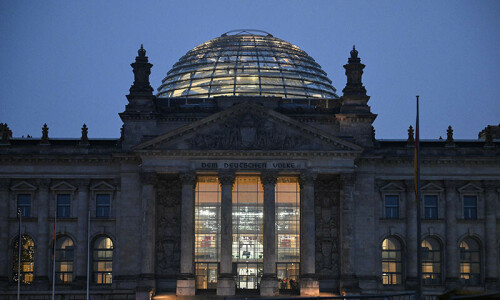APART from its strategic and regional connectivity outlook, the China-Pakistan Economic Corridor had also offered hope for Pakistan’s economic revival and industrial transformation. But that hope has gradually been waning. Not only have the power elites not been able to assess and strategise the real potential of the initiative, the implementing apparatus too was seen as disjointed and unprepared. CPEC could also do wonders for the sociopolitical and cultural transformation of the country, which is plagued by a variety of extremist and conservative tendencies. These tendencies are not only damaging the social fabric, they have also led to a mindset that is retrogressive and uncreative.
CPEC was, and still remains, an opportunity to introduce a multicultural character. At the outset, CPEC had encouraged medium- to large-scale Chinese investors to invest in Pakistan. But the nexus of the bureaucracy and conservative industrial class held the Chinese off. At the other end, society, too, was not ready to interact with such a large number of foreigners entering the local market. Security and political factors further complicated the situation.
So far, CPEC has failed to create any kind of sociocultural fusion in society.
The mega projects of CPEC, which entail sovereign guarantees, are still ongoing, but the establishment of the economic zones and cooperation in the industrial and agricultural sectors have slowed to a snail’s pace in recent years. Chinese investors have other attractive destinations where they can enlarge their profits, especially countries which not only have an appetite for foreign investment but also offer a milieu of sociopolitical and cultural acceptance for foreigners. It goes without saying that multicultural and diverse countries attract more foreign investment.
Pakistan has a diverse religious, ethnic and cultural profile but it is struggling to create harmony in diversity. The state and a major segment of society, ie the clergy, have taken the entire societal discourse to the level of exaggerated religious zeal where little space is left to accept or celebrate diversity. As a result, society sees anything that is new and different with suspicion, including foreigners and among the latter especially whose are not co-religionists.
Unfortunately, the country had lost its appeal for international tourists long before the post-9/11 wave of terrorism arrived at its shores. The emerging insecurity and violence had made security agencies overly sensitive to foreigners either from the West or the South Asian neighbourhood; in most instances, these foreigners were viewed as potential enemies of the country. In the process, to counter foreign threats, state institutions have developed such strict visa regimes and protocols (not only for international NGOs and tourists but also for investors) that one thinks multiple times before deciding to visit Pakistan.
The media coverage of a German tourist couple staying in a vehicle in Lahore is just one example of how paranoid our society has become regarding the presence of foreigners in the country. The couple that was on a mission to travel the world in their car was harassed by the local media, who called them spies and described them as ‘mysterious’. They were on their way to India but the Covid-19 pandemic and visa restrictions forced them to stay longer in the city.
As compared to other nations in the region, a common Pakistani has minimal chances to interact with foreigners. Pakistani people have more opportunities to interact with other nationals if they are going to the Gulf and East Asian countries for economic reasons or to study abroad. The Pakistani diaspora in the West is sizable but it is not diverse and mainly hails from specific regions of the country. Even they face issues while living in multicultural societies.
CPEC has brought thousands of Chinese nationals to Pakistan. They are either working on projects, or exploring avenues of investment. The Chinese government also encouraged people-to-people contact and arranged visits for the media, academics, politicians, businessmen, and youth in the hope of a better cultural and social understanding of each other. Almost 23,000 Pakistani students are studying in various disciplines in Chinese educational institutions. Initially, Pakistanis were enthusiastic about Chinese nationals and receptive to the idea of visitors, but the cultural gaps have gradually widened. The security situation has also forced Chinese workers to restrict their movement and interaction with the locals. People-to-people contact has not yielded the desired results, as Pakistanis, though recognising Chinese progress, have not been receptive to Chinese culture. So far, CPEC has failed to create any kind of sociocultural fusion in society.
A look at the global tourism landscape suggests that the Chinese were contributing to the tourism industry before the coronavirus pandemic emerged, However, Pakistan’s share was negligible. Prime Minister Imran Khan is enthusiastic about tourism in Pakistan but apart from the very poor tourism infrastructure in the country, the mindsets of both state institutions and society are a major hindrance in the way of exploiting tourism’s potential.
A multicultural character is also an answer to the persisting extremism in our society. It can create spaces and acceptance for the country’s own diversity. It enriches societies and broadens the horizons of individuals. CPEC is a huge opportunity for developing this aspect of Pakistani society, especially when Pakistanis have few opportunities of interacting with nationals of other countries. Many analysts projected the Belt and Road Initiative including CPEC as the revival of the old Silk Route, which had connected civilisations and cultures and introduced Buddhism, Christianity and Islam to China. It had also helped in the exchange of knowledge of technology as well as helped develop trade, commerce, and cooperation.
China and Pakistan enjoy an excellent strategic and political relationship and it was expected that the Chinese would be well received in the country. CPEC was also conceived as a social and cultural catalyst for the country, but that enthusiasm is apparently on the wane at the moment.
The writer is a security analyst.
Published in Dawn, February 7th, 2021











































